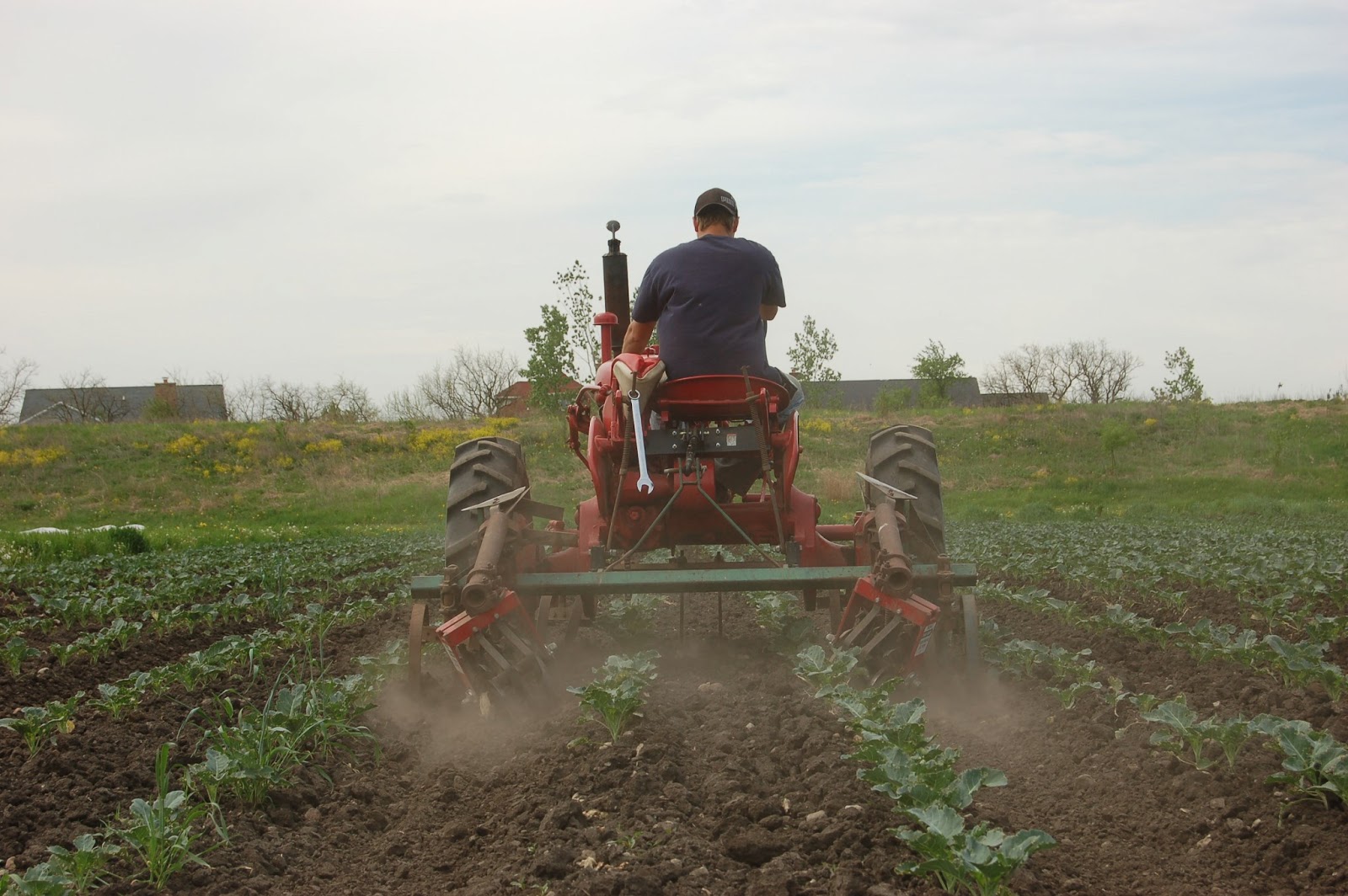This Week's Vegetable Share
- Spinach
- Two Types of Head Lettuce
- Rhubarb (from Tipi Produce in Evansville, WI)
- Easter Egg Radishes
- Baby Salad Turnips
- Green Onions
- Two Bunches of Asparagus
Crop Report
It's been almost a month since planting season started. So far we've planted about 12 acres, but there are a number of important crops that still need to be planted--tomatoes, peppers, eggplant, basil, sweet potatoes, more lettuce, more zucchini, more beans, more cucumbers, more...well, you get the idea. In the photo below, Nadia is planting a field of green beans.
This week, in addition to planting, we've added cultivating to the list of jobs that need to be done. Mechanical cultivation refers to the use of tractors equipped with blades and discs to control weeds in our vegetable rows. We use a number a tractors, including the 1949 Allis Chalmers G pictured below, for knocking out small weeds before they become big problems. In this picture, Jeff cultivates tiny carrot seedlings while Sally the Farm Dog looks on.
Meanwhile, Tyler cultivates the first planting of broccoli. If you look closely, you can see that there are blades mounted on a tool bar behind the tractor. There is one set of blades near each tire. As Tyler drives along, the sharp blades rotate and knock out weeds on the outside edges of the broccoli rows.
Vegetable Notes
Rhubarb rivals asparagus as the quintessential spring food. Rhubarb is high in vitamins A and C and a variety of minerals, particularly calcium. It may be refrigerated in a plastic bag for up to 2 weeks. For long-term storage, wash rhubarb, chop it, then put in freezer bag and freeze it. It will be soft when thawed, but will still work beautifully in most recipes.
Easter egg radishes come in shades of violet, pink, purple, white and red. We like these radishes for their beautiful colors and for their tendency to stay crisp in all kinds of weather. If you're looking for a use for radishes that's a little out-of-the-ordinary, I recommend making radish salsa (chopped radishes, green onion, lime juice, salt and pepper) to serve with chips, in burritos, or as an accompaniment to a grilled steak.
This Week's Featured Recipes
Radish and Cream Cheese Spread with Green Onions & Feta
2 cups halved or quartered radishes
1 cup chopped green onions, white and green parts
8 ounces (or more) cream cheese, softened
4 ounces feta cheese, crumbled (optional)
1 Tablespoon fresh lemon juice
¾ teaspoon salt (start with less if you're including the feta)
Several grinds of fresh pepper
Process the radishes and green onions in a food processor until finely chopped. Add the cream cheese, feta cheese (if using—or you can always stir it into part or all of the batch later), lemon juice, salt, and pepper and process until smooth, scraping down the sides of the processor bowl as necessary. Add more cream cheese if you'd like a thicker sandwich spread. Serve with crackers, pita chips or baguette slices.
from farmgirlfare.com
Barley Salad with Radishes, Asparagus & Green Onions
1 cup pearled barley
1 lb asparagus, cut into 1-inch pieces and cooked until just tender, blanched in cold water
2 celery stalks, diced
6-8 radishes, thinly sliced
1/4 cup chopped green onions, white and green parts
for the dressing:
1 part extra-virgin olive oil
1 part lemon juice
1/2 part white wine vinegar or white balsamic vinegar
salt and pepper to taste
Cook barley according to package directions. Make sure not to overcook. Drain and rinse with cold water to stop cooking. Put the barley in a big bowl and add the asparagus, celery, radishes, and green onion. In a jar with a lid, mix ingredients for the dressing. Pour over salad and mix gently before serving.
Waffles with Rhubarb Sauce
for the sauce
1 1/4 pounds rhubarb, trimmed and diced (1/4 inch), about 5 cups
1 cup sugar
for the waffles
3 large egg whites
1 1/4 cups milk
1 1/2 tablespoons canola oil
1 1/2 cups all-purpose flour
1/4 cup whole-wheat flour
3 tablespoons sugar
1 tablespoon baking powder
1/4 teaspoon salt
To prepare sauce: Combine rhubarb and sugar in a medium saucepan and bring to a simmer over medium-low heat. Cook until the rhubarb is tender and translucent. Transfer about 1 cup of the rhubarb to a small bowl with a slotted spoon, and reserve for the waffle batter. Cook the remaining rhubarb sauce over medium heat, stirring occasionally, until slightly thickened, 5 to 7 minutes.
To prepare waffles: Whisk egg whites in a large bowl until frothy. Whisk in milk and oil. Stir in the reserved 1 cup cooked rhubarb. Sift all-purpose flour, whole-wheat flour, 3 tablespoons sugar, baking powder and salt into a medium bowl. Gently stir the dry ingredients into the egg-milk mixture just until moistened.
Preheat waffle iron. (If your waffle iron is not nonstick, brush it lightly with oil.) Fill the iron about two-thirds full. Close and cook the waffles until they are nicely browned, about 4 minutes. Repeat with the remaining batter, coating the waffle iron lightly with oil, if necessary, before cooking each batch. Serve hot, topped with the rhubarb sauce.
adapted from a recipe in Eating Well magazine
Next Week's Vegetable Harvest (our best guess): spinach, baby fennel, asparagus, lettuce, garlic chives and more!



